Theseus and Dedalus: Shadows of A Midsummer Night's
Dream in A Christmas Tale (Arnaud Desplechin)
Nathalie Crouau
1 The Vuillard family is preparing to celebrate Christmas in Roubaix in Abel and Junon's house. Shortly before Christmas, Junon (Catherine Deneuve) learns that she suffers from a possibly fatal disease and is in need of a bone marrow transplant. Tests are run and two possible donors are found: her son Henri (Mathieu Amalric), who has been banished from the family for several years after a mysterious quarrel with his sister Elizabeth (Anne Consigny) and her grandson Paul (Emile Berling), Elizabeth's son. As all the family members, including Henri, convene in Roubaix for the holidays, tempers run high, family issues resurface and new love interests are found. When everyone is on their respective ways back home, Junon undergoes the transplant but its success or failure remains unknown. In an optimistic epilogue where she predicts that all will turn out well, Elizabeth concludes the film by quoting from Puck's speech at the end of the play.
2 Like other films by Arnaud Desplechin, Un Conte de Noël (A Christmas Tale, 2008) is peppered with numerous literary, filmic, musical, pictorial and philosophical allusions and references, including some to A Midsummer Night's Dream. What sets the latter apart from the other allusions is that references to the Dream recur several times throughout the film and end up forming a coherent network which echoes the themes and parallels the structure of the main story. Although there is but one direct quotation from Shakespeare's play, its structural and thematic influence is felt from the beginning to the end of the film through the two following aspects: the repeated appearances of the theatre and the metaphors of the labyrinth.

The cast of A Christmas Tale, by Arnaud Desplechin
Theatre
The epilogue and the prologue: shadow theatre
3 Desplechin's film closes with a quotation from A Midsummer Night's Dream, taken from the end of the play (Epilogue, 1-3). Puck invites the spectators to leave behind the troubling images of the play and think that they were but a dream. The ending of the film thus corresponds with the ending of the play by guiding the spectator out of the dream. Indeed, the last scene of the film, which acts as the epilogue, is an awakening. Elisabeth, who happens to be a playwright, is absorbed in her writing while we hear her thoughts in voice-over. Significantly, the first words we hear are: "Je me suis réveillée tôt" ["I woke up early"]. She goes on to express her optimistic belief in a happy resolution to the issues previously raised by the plot, namely her mother's illness and the outcome of the bone marrow transplant that is attempted in order to cure her: "Junon va guérir, la greffe va prendre" ["Junon will be cured, the transplant will be a success"]. Then, the first notes of Mendelssohn's Overture to A Midsummer Night's Dream are heard as she quotes Puck's lines in voice over: "Ombres que nous sommes, si nous avons déplu, pensez ceci: que vous n'avez fait que dormir et tout sera réparé" ["If we shadows have offended, / Think but this, and all is mended, / That you have but slumber'd here"]. This is the most direct reference to Shakespeare's play in the film, however there is yet another, more indirect allusion, in this scene. It takes the shape of a small shadow theatre, sitting on a shelf above Elisabeth's desk and bearing the name "le palais de Thésée" [Theseus' palace]. This shadow theatre directly echoes the prologue of the film, since it is used at the beginning for the exposition. Elisabeth's voice narrates the story of her family as it is represented by the little shadows in the theatre. Using a play to tell a story is, after all, the most congenial mode of expression for her as a dramatist. This theatrical approach to the Christmas tale also highlights the symmetry with the epilogue and establishes a recurrent pattern of connections between the film and the theatre.
4 One such connection can be seen when the Christmas play, written by Ivan Vuillard's (Melvil Poupaud) children, is announced by a title plate, inserted in the manner of an intertitle in a silent film. The assembled family is about to attend a performance of "Le Drame du prince Zorro" [The Drama of Prince Zorro].
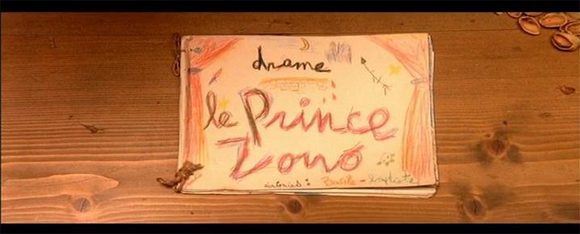
The intertitle introducing the play within: The Drama of Prince Zorro
The play within
5 Although this is not a play within a play, but within a film, the place of the "Drama of Prince Zorro" in Un Conte de Noël mirrors that of "The Lamentable Comedy of Pyramus and Thisbe" in A Midsummer Night's Dream. In Shakespeare's play, the misadventures of the crossed lovers, Pyramus and Thisbe, parallel those of Hermia and Lysander who are forbidden to marry by Hermia's father. In Desplechin's film, the editing of the passage highlights the parallels between the scene played by the children downstairs and the verbal fight taking place upstairs. Besides, the "Drama of Prince Zorro" strangely resembles Henri's life story.
6 The first clue to the fact that the two plots are interwoven is that the title plate of the play within appears long before the play is due to begin. The preparations for the show overlap those for the Christmas dinner. One after the other, all the rooms in the house are taken over by the theatre: in the living room Paul places the seats and Basile and Baptiste sell tickets to the arriving spectators; the bathroom is turned into a dressing room where Abel and Sylvia are getting ready. There they discuss their make-up, their cues and the need to improvise. Upstairs as well, preparations are under way, gifts are being wrapped.
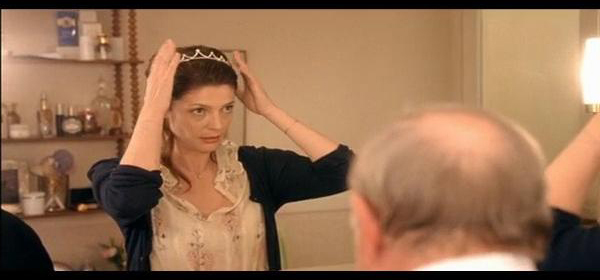
In the bathroom turned dressing room, Abel (Jean-Paul Roussillon) and
Sylvia (Chiara Mastroianni) are getting ready to perform in the play within
7 When Henri arrives on the upstairs landing to the sound of a trumpet, he announces that the show is about to start. The sound of the trumpet, rallying the spectators for the beginning of a play, is another clue that the show will take place both downstairs and upstairs.
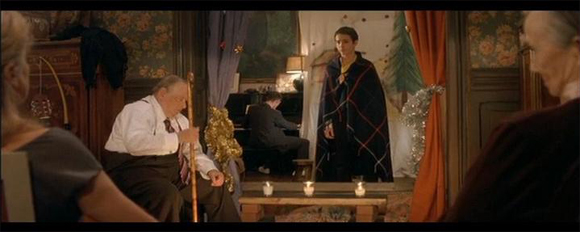
The play within begins
8 Thus a parallel is established between the plot of the play within and that of the film. Prince Zorro is banished from the castle by his sister after stealing from the peasants who are then left to starve. In a similar way, Henri was banished from the family by his sister Elisabeth after causing the bankruptcy of the theatre where he used to produce her plays. In both cases the banishment springs from a family taboo. Nobody seems to be able to explain the source of Elisabeth's hatred for her brother which not even the financial setbacks can account for. Likewise, Prince Zorro's crime (having sex with a goat, as is later revealed) is unutterable. Both families offer forgiveness in exchange for a personal sacrifice. The only remedy to Prince Zorro's meanness is to cut off his arm. Likewise, by giving Junon some of his bone marrow, Henri is welcomed back into the family.
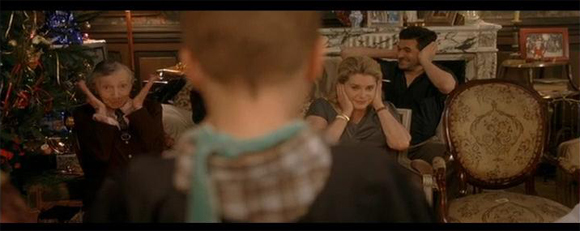
Prince Zorro’s unspeakable crime: “Je ne le dirai pas parce que ce serait trop horrible et vos
oreilles saigneraient” [“I won’t say it because it would be too horrible and your ears would bleed”]
9 In addition to the connections this episode creates between the play within and the film at large, it also alludes more directly to A Midsummer Night's Dream through the echoes between the "Drama of Prince Zorro" and Shakespeare's play. The children actors, like the mechanicals, are amateurs, therefore their lack of skill appears in their exaggerated, slightly ridiculous way of acting. In the same way that the mechanicals fear that ladies in the audience might faint at the sight of a roaring lion on the stage (III.1.25-42), the children are particularly concerned lest their play might shock or frighten: "Je ne le dirai pas parce que ce serait trop horrible et vos oreilles saigneraient" ["I won't say it because it would be too horrible and your ears would bleed"]. Generic confusion causes Zorro, who is usually perceived as a hero, to become the monster and villain of the piece, much as the tragedy of Pyramus and Thisbe ends up being a comedy when performed by Peter Quince's company. Zorro's unspeakable crime – "J'ai couché avec une bique" ["I slept with a goat"] – recalls Titania's unnatural coupling with Bottom, a creature which is half-man, half-ass. Basile's and Baptiste's costumes hint at those of the mechanicals: one wears a fur-like vest and a bowtie which looks like a lion's whiskers – a possible allusion to the lion – the other wears around his neck a star-shaped medallion – a possible allusion to the moon. Finally, the spectators are shown quite as much as the performers, their reactions to the unravelling of the play reflecting the commentaries of the Athenian spectators upon the performance of Pyramus and Thisbe.
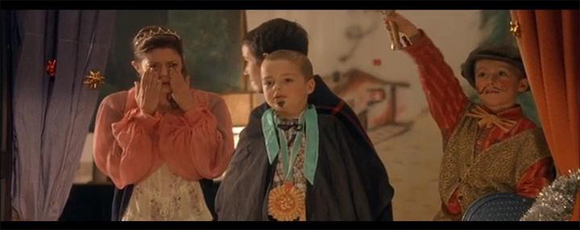
Sylvia (Chiara Mastroianni, left), Paul Dedalus (Emile Berling, centre, upstage), Basile (Thomas
Obled, centre, downstage) and Baptiste (Clément Obled, right) perform the Drama of Prince Zorro
10 The whole Vuillard family is thus affected by a passion for the theatre. On top of young Basile's and Baptiste's amateur theatricals, there is also a bona fide playwright in the family, namely Elisabeth. Two of her plays are referred to in the film through an article in the local newspaper which extols Elisabeth's latest work and announces that it is being performed in London. The title of the play – Lost in the Wood – can be interpreted as an allusion to A Midsummer Night's Dream, more particularly to the lovers who get lost and spend the night looking for one another in the wood. The ad on the same newspaper page refers to another play by Elisabeth called Cartes, compas, boussole [Maps and Compasses]. Taken together, those titles suggest loss of bearings, aimless wanderings and the desire to find one's way. They also hint at another motif which is related to Shakespeare's play: the labyrinth.
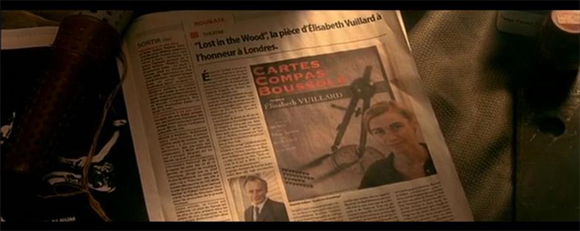
An article in a local newspaper about Elisabeth Vuillard’s latest play: Lost in the Wood
The labyrinth
The city labyrinth
11 In A Midsummer Night's Dream, the labyrinth is the forest where the lovers are in constant pursuit of one another. In Un Conte de Noël, the four lovers are replaced by a love triangle made up of Sylvia Vuillard (Chiara Mastroianni), her husband Ivan and his cousin Simon (Laurent Capelluto). Upon the occasion of spending Christmas in Roubaix with the Vuillard family, Sylvia discovers that Simon has always been in love with her. When they first met, many years before, the boys settled between themselves that Ivan would be the one to have her. Upon learning that she, like Hermia, has been unwittingly forced to choose love "by another's eyes" and denied the possibility to choose for herself, Sylvia decides to go in pursuit of Simon.
12 On Christmas Eve, after they come back from the midnight mass, the family realise that Simon is missing. Supposing him, from past experience, to be drunk somewhere in a bar, Ivan and Sylvia set out separately to look for him. As they get into their cars, Mendelssohn's Overture can be heard. Their quest for Simon is then represented by a street map of Roubaix with the neon signs of innumerable bars superimposed upon it in succession, suggesting a chase that is both long and difficult.
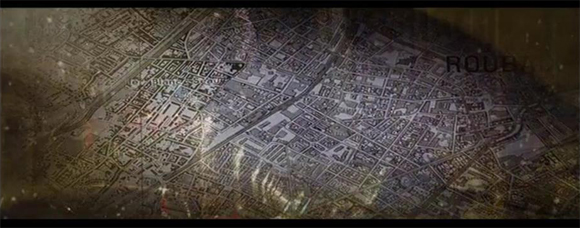
Lost in Roubaix: a map of the town is superimposed on an image of
Ivan and Sylvia setting out in search of Simon
13 This map of Roubaix seen from above symbolizes the maze where the lovers wander in search of one another. The connexion with Shakespeare's play is highlighted by the musical reference. The map labyrinth also establishes a parallel between the city of Roubaix and the forest in A Midsummer Night's Dream. Roubaix plays a very important part in this, as indeed in a lot of other films by Desplechin (it is his hometown). Its name is used as a subtitle for the film (Un Conte de Noël – Roubaix!). The movement towards Roubaix at the beginning, then away from Roubaix at the end, echoes the lovers' flight into the forest at night and then their return to Athens in the morning. This is emphasised by the fact that, on their way to Roubaix or upon their arrival there, most of the characters fall asleep: Ivan and Simon in the train from Lille to Roubaix, Paul and Elisabeth at Abel and Junon's. Conversely, the end of the film is the time of awakening: Abel watches Junon as she wakes up, Sylvia awakes in the bed of a man who is not her husband and in the epilogue, Elisabeth mentions that she woke up early.
14 Through the symbol of the labyrinth, Roubaix, the place where the wandering characters find themselves and each other, represents the completion of a long and difficult personal journey. There is another allusion to the labyrinth in the film, however, through the character of the psychologically disturbed teenager, significantly named Paul Dedalus.
The wanderings of Paul Dedalus
15 The name Paul Dedalus refers to several things at once. It firstly refers to Desplechin's work itself, since it is also the name of the character played by Mathieu Amalric in Rois et reine (Kings and Queen, 2004), his previous film and, of course, to the myth of Dedalus, first creator and then prisoner of the labyrinth he designed.
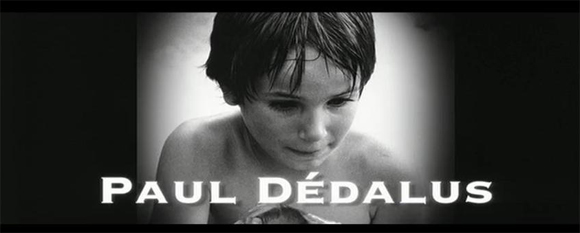
The intertitle introducing the character of Paul Dédalus
16 Paul Dedalus is, from the first, presented as unbalanced. In the beginning of the film, he tries to hurt himself with a knife and is sent into a psychiatric hospital for a short stay. His tactless uncle Henri keeps referring to him as "the madman." These elements suggest that Paul's wanderings are of the mind. Shortly after he has arrived in Roubaix, he finds himself alone in the library/living room watching an old film on television. It is William Dieterle and Max Reinhardt's 1935 adaptation of A Midsummer Night's Dream. In this scene again, as in that of the children's theatricals, we can find some parallels between the film within and the character watching it. The mental labyrinth in which Paul is lost is echoed in the three extracts from the 1935 film that are shown in this episode.
17 The first extract evokes Hermia's wanderings through the forest after being deserted by Lysander. The second extract shows Titania waking up next to Bottom. Horrified, she exclaims: "An ass!" while Oberon looks on with a mocking smile on his face. The third extract occurs as Titania and Oberon, reconciled, fly away in the breaking dawn. These three episodes reflect three stages of the myth: the winding progress towards the centre of the labyrinth, the encounter with the creature that resides there and the exit from the labyrinth with the return of the morning.
18 While Paul is watching the monster of the forest – who is Bottom – on the TV screen, another monster, in the shape of a wolf, appears in the room he is standing in. As the camera swivels rapidly from Paul to Bottom to the wolf, it seems to establish a connection between the three. On the other side of Paul stands a mirror where the wolf is reflected, giving the impression that he is surrounded by monstrous creatures. As it happens, Abel and Junon's house is the lair of an imaginary monster, a wolf called Anatole, who lives in the cellar according to family legend, passed on from generation to generation, either to entertain children or to frighten them into obedience. This seems to point to the family house as the centre of the labyrinth that is Roubaix. The brusque departure of the wolf from the room coincides with Titania's and Oberon's in the last extract from the film.
19 It is the figure of Theseus which connects and helps make sense of the multiple allusions to A Midsummer Night's Dream. In Shakespeare's play, Theseus' palace was turned into a theatre since it became the venue for the performance of "Pyramus and Thisbe". In Desplechin's film, Theseus' palace is the name given to the small shadow theatre where two different plays are performed. In the prologue of the film, the shadows tell the story of the Vuillard family. In the epilogue, the shadow theatre displays a performance of A Midsummer Night's Dream. We may indeed recognize Bottom, Puck and possibly Titania or Oberon in the three small figures that appear there. It is thus the epilogue of the film which gives the most significant clue to understanding the successive allusions to A Midsummer Night's Dream. In a setting borrowed from the prologue – the background picture of the shadow theatre remains the same – it substitutes Shakespeare's characters for the Vuillard family.
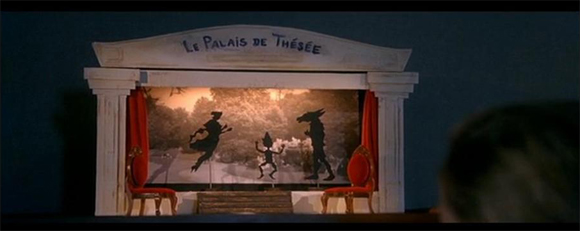
The little shadow theatre above Elisabeth’s desk: Theseus’s palace
20 In an interview with Le Nouvel Observateur (May 15, 2008), as the journalist asked him what his references were for Un Conte de Noël, Arnaud Desplechin answered thus: "Emmanuel Bourdieu and I read The Winter's Tale fourteen times but we were unable to use a single scene or even a line from it. Then, during the editing process, I realised that the structure of the film mirrored that of A Midsummer Night's Dream, an extract of which the young boy watches on television, in a Hollywood adaptation. This truly was a Freudian slip. Even today, as I'm working on the mixing of the film, I still haven't completely acknowledged all those Freudian slips" (my translation).
21 An abundance of varied references characterises Desplechin's style and it appears that the Freudian slips he evoked in this interview go beyond this one film and in fact spread from one film to the next: the same names can be found for the characters of different films (Vuillard, Dedalus), the same actors (Mathieu Amalric, Emmanuelle Devos, Jean-Paul Roussillon) constitute Desplechin's cinema family, the same family troubles are a recurrent topic. References to Shakespeare also keep cropping up in his work: King Lear in Esther Kahn (2000), Hamlet in La Sentinelle (The Sentinel, 1992), The Tempest in Rois et reine (Kings and Queen, 2004).
22 In Un Conte de Noël itself, there is a possible – though very indirect – allusion to another of Shakespeare's plays, through the first name of Henri's girlfriend Faunia which refers to the source for The Winter's Tale, Pandosto or "Dorastus and Fawnia." It would be interesting, therefore, to widen the search for Shakespearean references to the whole of Desplechin's work and, by so doing, track down the director's Freudian slips, so to speak.
How to cite
CROUAU, Nathalie. "Un Conte de Noël by Arnaud Desplechin." In Nathalie Vienne-Guerrin & Patricia Dorval (eds). Shakespeare on Screen in Francophonia: The Shakscreen Collection 1. Montpellier (France): IRCL, Université Paul-Valéry/Montpellier 3, 2012. Online: http://shakscreen.org/analysis/analysis_christmas_tale_2011/ (last modified June 26, 2012).
Contributed by Nathalie CROUAU
<< back to top >>




